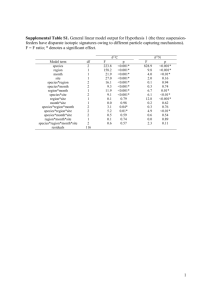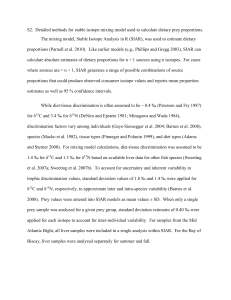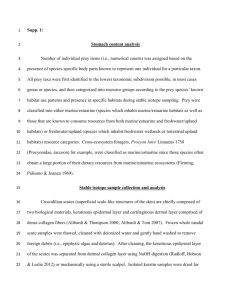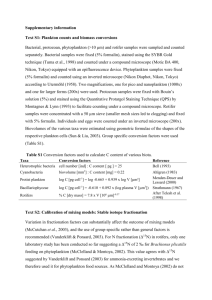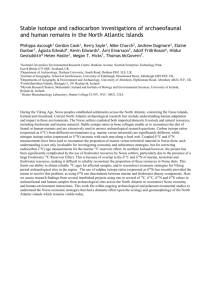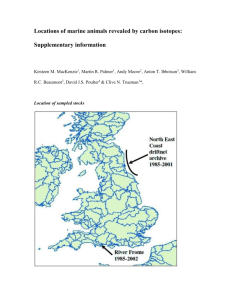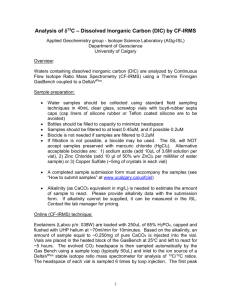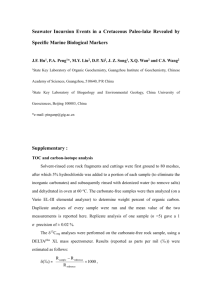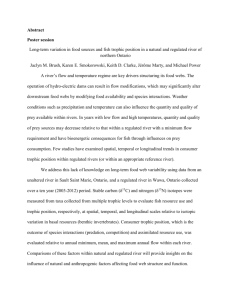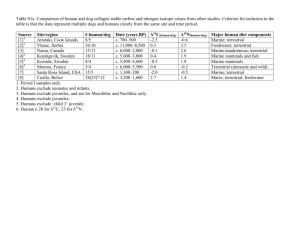Using Stable Isotope Compositions of Animal Tissues to
advertisement
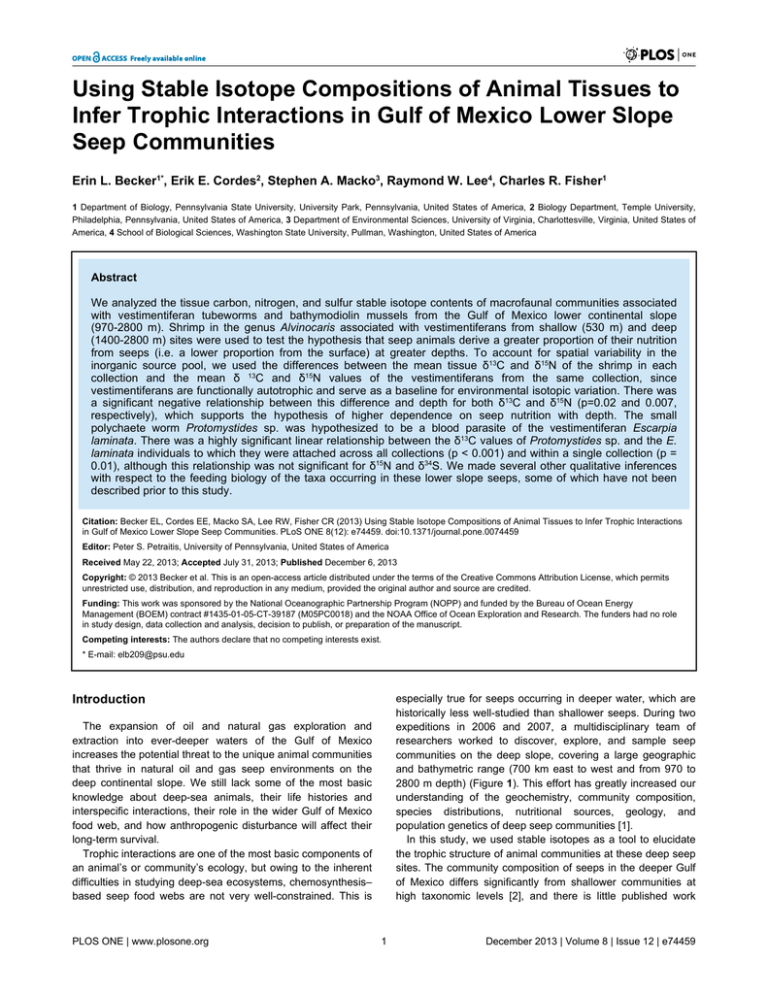
Using Stable Isotope Compositions of Animal Tissues to Infer Trophic Interactions in Gulf of Mexico Lower Slope Seep Communities Erin L. Becker1*, Erik E. Cordes2, Stephen A. Macko3, Raymond W. Lee4, Charles R. Fisher1 1 Department of Biology, Pennsylvania State University, University Park, Pennsylvania, United States of America, 2 Biology Department, Temple University, Philadelphia, Pennsylvania, United States of America, 3 Department of Environmental Sciences, University of Virginia, Charlottesville, Virginia, United States of America, 4 School of Biological Sciences, Washington State University, Pullman, Washington, United States of America Abstract We analyzed the tissue carbon, nitrogen, and sulfur stable isotope contents of macrofaunal communities associated with vestimentiferan tubeworms and bathymodiolin mussels from the Gulf of Mexico lower continental slope (970-2800 m). Shrimp in the genus Alvinocaris associated with vestimentiferans from shallow (530 m) and deep (1400-2800 m) sites were used to test the hypothesis that seep animals derive a greater proportion of their nutrition from seeps (i.e. a lower proportion from the surface) at greater depths. To account for spatial variability in the inorganic source pool, we used the differences between the mean tissue δ13C and δ15N of the shrimp in each collection and the mean δ 13C and δ15N values of the vestimentiferans from the same collection, since vestimentiferans are functionally autotrophic and serve as a baseline for environmental isotopic variation. There was a significant negative relationship between this difference and depth for both δ13C and δ15N (p=0.02 and 0.007, respectively), which supports the hypothesis of higher dependence on seep nutrition with depth. The small polychaete worm Protomystides sp. was hypothesized to be a blood parasite of the vestimentiferan Escarpia laminata. There was a highly significant linear relationship between the δ13C values of Protomystides sp. and the E. laminata individuals to which they were attached across all collections (p < 0.001) and within a single collection (p = 0.01), although this relationship was not significant for δ15N and δ34S. We made several other qualitative inferences with respect to the feeding biology of the taxa occurring in these lower slope seeps, some of which have not been described prior to this study. Citation: Becker EL, Cordes EE, Macko SA, Lee RW, Fisher CR (2013) Using Stable Isotope Compositions of Animal Tissues to Infer Trophic Interactions in Gulf of Mexico Lower Slope Seep Communities. PLoS ONE 8(12): e74459. doi:10.1371/journal.pone.0074459 Editor: Peter S. Petraitis, University of Pennsylvania, United States of America Received May 22, 2013; Accepted July 31, 2013; Published December 6, 2013 Copyright: © 2013 Becker et al. This is an open-access article distributed under the terms of the Creative Commons Attribution License, which permits unrestricted use, distribution, and reproduction in any medium, provided the original author and source are credited. Funding: This work was sponsored by the National Oceanographic Partnership Program (NOPP) and funded by the Bureau of Ocean Energy Management (BOEM) contract #1435-01-05-CT-39187 (M05PC0018) and the NOAA Office of Ocean Exploration and Research. The funders had no role in study design, data collection and analysis, decision to publish, or preparation of the manuscript. Competing interests: The authors declare that no competing interests exist. * E-mail: elb209@psu.edu Introduction especially true for seeps occurring in deeper water, which are historically less well-studied than shallower seeps. During two expeditions in 2006 and 2007, a multidisciplinary team of researchers worked to discover, explore, and sample seep communities on the deep slope, covering a large geographic and bathymetric range (700 km east to west and from 970 to 2800 m depth) (Figure 1). This effort has greatly increased our understanding of the geochemistry, community composition, species distributions, nutritional sources, geology, and population genetics of deep seep communities [1]. In this study, we used stable isotopes as a tool to elucidate the trophic structure of animal communities at these deep seep sites. The community composition of seeps in the deeper Gulf of Mexico differs significantly from shallower communities at high taxonomic levels [2], and there is little published work The expansion of oil and natural gas exploration and extraction into ever-deeper waters of the Gulf of Mexico increases the potential threat to the unique animal communities that thrive in natural oil and gas seep environments on the deep continental slope. We still lack some of the most basic knowledge about deep-sea animals, their life histories and interspecific interactions, their role in the wider Gulf of Mexico food web, and how anthropogenic disturbance will affect their long-term survival. Trophic interactions are one of the most basic components of an animal’s or community’s ecology, but owing to the inherent difficulties in studying deep-sea ecosystems, chemosynthesis– based seep food webs are not very well-constrained. This is PLOS ONE | www.plosone.org 1 December 2013 | Volume 8 | Issue 12 | e74459 Trophic Interactions Gulf of Mexico Seep Animals Figure 1. Map of collection sites on the Gulf of Mexico lower continental slope. The site names are based on Bureau of Ocean Energy Management (BOEM) lease block designations and consist of a two-letter abbreviation, which stands for the region (AC=Alaminos Canyon, for example), followed by a three-digit number. The yellow text gives the name for the region, while the white points and text signify the specific study sites. The notations inside the brackets indicate how many of each community type was collected at a site: C=vesicomyid clams (Calyptogena ponderosa and an undescribed vesicomyid), M=mussels (Bathymodiolus spp.), and V=vestimenitiferans (Escarpia laminata and Lamellibrachia spp.). The bathymetric depth is given in meters below the site name. about the feeding biology of most of the taxa occurring in deeper water. Stable isotope analysis is a valuable tool in the deep sea where direct observation and gut content analysis are difficult (many animals are very small and some thoroughly grind their food) and has led to some of the most significant discoveries about the nutrition of cold seep and related hydrothermal vent animals [3,4,5,6]. We made quantitative collections of the communities associated with two dominant seep taxa: vestimentiferan tubeworms and bathymodiolin mussels. These taxa dominate biomass at seeps, contain symbiotic bacteria that provide their nutrition, and provide habitat for a community of smaller animals. Although there is some overlap in the species associated with vestimentiferans and mussels, there are significant differences in species composition of the associated communities and, due to differences in their symbionts and life histories, they inhabit very different geochemical habitats [2]. Mussels have methanotrophic symbionts in their gills and therefore live in active seep sites where methane is present in the bottom water above the sediment surface, while vestimentiferans have chemoautotrophic sulfide-oxidizing symbionts and can live in less active locations because of their ability to mine sulfide from the sediment through their “roots” [7]. In total, we made 11 vestimentiferan and 20 mussel community collections from 970 to 2800 m depth (see also 8). PLOS ONE | www.plosone.org Additionally, data were included from vestimentiferan communities collected at 530 m depth for comparison with deeper sites [9]. The extensive sampling allowed us to discern qualitative patterns and make inferences about the feeding biology of seep animals. We also tested the long-standing hypothesis that generalist seep animals (those that obtain nutrition from both surface and seep primary production) derive a greater proportion of their nutrition from seeps as depth increases. This hypothesis is based on the fact that organic material produced by photosynthesis at the surface is consumed and degraded as it sinks toward the bottom, and thus, less of it is available for consumption at greater depths. This is supported by a general trend of decreasing benthic biomass with increasing depth in the “normal” deep sea [10], but no data exist that support this trend for vents and seeps, where primary production occurs locally via chemosynthesis. We tested this hypothesis by comparing the stable isotope compositions of alvinocarid shrimp from shallow and deep vestimentiferan communities to determine whether there is isotopic evidence of greater usage of seep-derived nutrition at greater depths. Organic matter from the photic zone has δ13C values between -23 and -19‰ [11], and carbon fixed by chemoautotrophy ranges from -75 to -28‰ [12,13], with the more negative values in this range indicating carbon derived 2 December 2013 | Volume 8 | Issue 12 | e74459 Trophic Interactions Gulf of Mexico Seep Animals Methods Study sites The study sites are named according to the Bureau of Ocean Energy Management lease block designations. Each name includes a two-letter abbreviation for the region (e.g. GC for Green Canyon) followed by a three-digit number. The 13 sites in this study are located along the lower continental slope of the Gulf of Mexico from 225 km south of Texas near the TexasLouisiana border to the south of Alabama (Table 1, Figure 1). Sites ranged in depth from 970 m to 2800 m. Descriptions of the study sites are given in [17] and [18]. Data was also included from a site at 530 m for comparison between shallow and deep sites (Figure 1). Habitat-forming fauna Vestimentiferans and bathymodiolin mussels are the most common and abundant symbiotic taxa in cold seeps on the Northern Gulf of Mexico lower slope. Here, there are three vestimentiferan species: Escarpia laminata and Lamellibrachia sp. 1 are common and frequently co-occur in the same aggregations, and Lamellibrachia sp. 2 is rare and occurs with the other two [19]. The δ13C and δ34S values of co-occurring species were not found to be significantly different, but δ15N values in E. laminata were consistently more enriched than Lamellibrachia sp. 1 by 2.6 ± 0.7‰ [20]. All known vestimentiferans contain sulfide-oxidizing chemoautotrophic endosymbionts. The associated community inhabits the chitinous tubes and interstices of vestimentiferan aggregations, and older worms can extend up to a meter above the sediment surface, providing habitat with very little exposure to seeping fluids [7,21]. In very old vestimentiferan aggregations on the upper slope, seepage may be undetectable even at the sediment surface [21], and the vestimentiferans survive by mining sulfide from deep in the sediment with their buried “roots” [7]. The three bathymodiolin mussel species that occur on the lower slope are Bathymodiolus childressi, which is also common in shallower seeps (overall depth range 525 to 2284 m and collected between 1005 and 2284 m in this study), B. brooksi (collected between 1080 and 2745 m), and B. heckerae (collected between 2180 and 2745 m) [2]. Where the depth ranges of these species overlap, B. brooksi often co-occurs in the same aggregations with either B. childressi or B. heckerae, but the latter two species have never been found to co-occur. B. childressi has only methanotrophic symbionts [22], B. brooksi forms a dual symbiosis with both chemoautotrophic and methanotrophic bacteria [23], and B. heckerae contains four different symbionts: a methanotroph, two chemoautotrophs, and one methylotroph-related phylotype [24]. The associated community inhabits the shells of mussels and interstices between them. Mussel beds can be many layers thick, and because mussels lack binding proteins to transport molecules to their symbionts, they require sufficient concentrations of seep fluid and oxygen in the epibenthic water to support autotrophy. A third, less commonly observed symbiotic taxon at Gulf of Mexico seeps is the vesicomyid clams, which contain sulfide- Figure 2. A close-up photo of Protomystides sp. inhabiting its casing atop the obturaculum of Escarpia laminata. Stoloniferans are also shown attached to the anterior portions of vestimentiferan tubes. from methane, which itself can vary depending on whether it is of biogenic (δ13C ≈ -80 to -60‰) or thermogenic (δ13C ≈ -55 to -30‰) origin [14]. δ15N values in surface-derived organic material are generally greater than 6‰ [15], while seep animals can have δ15N that are much lower and even negative [13]. Thus, a trend of decreasing δ13C and δ15N values with depth could indicate increased usage of seep-derived nutrition. Two hypotheses of specific trophic relationships were also tested. While collecting vestimentiferan communities, clusters of the polychaete “cap worm” Protomystides sp. were observed living within a matrix of tubes affixed to the tops of the vestimentiferan Escarpia laminata (Figure 2). The guts of these worms were filled with a red substance resembling tubeworm blood. It was therefore hypothesized that Protomystides sp. is a blood parasite of E. laminata, and we tested for isotopic evidence of this trophic relationship. A polynoid Branchipolynoe seepensis lives in the gills of the seep mussel Bathymodiolus heckerae, and a nautilliniellid polychaete also lives in the gills of B. heckerae and vesicomyid clams (Calyptogena ponderosa and an undescribed vesicomyid). We looked for stable isotope evidence of a trophic relationship between the commensals and their bivalve hosts, as was previously found for Branchipolynoe symmytilida and the hydrothermal vent mussel Bathymodiolus thermophilus [16]. PLOS ONE | www.plosone.org 3 December 2013 | Volume 8 | Issue 12 | e74459 Trophic Interactions Gulf of Mexico Seep Animals Community collections Table 1. Information for each community collection whose stable isotope data are displayed in Figures 5, 6 and 7. Figure Collection ID* Sample Dive Latitude Longitude Depth 5A GB829m1 mpa J2-279 27:11.1 -92:07.5 1258 5B GC852m1 mp 4186 27:06.3 -91:09.9 1410 5C GC852m5 mpa J2-278 27:06.6 -91:09.9 1407 5D GC852m6 mpf J2-278 27:06.3 -91:09.9 1408 5E GB697m1 mp J2-274 27:18.7 -92:06.3 1005 5F GB697m2 ms J2-274 27:19.2 -92:06.6 1015 5G WR269m3 mpf J2-275 26:41.1 -91:39.7 1910 5H WR269m4 ms J2-275 26:41.1 -91:39.7 1910 6A AC601m1 mpb J2-283 26:22.1 -94:31.1 2284 6B AC601m2 mpd J2-283 26:22.1 -94:31.1 2284 6C AC645m4 mpb J2-281 26:21.2 -94:29.8 2197 6D AC818m1 mp 4192 26:10.8 -94:37.3 2744 6E AC818m2 ms 4195 26:10.8 -94:37.3 2745 6F AC818m3 mpb J2-282 26:10.8 -94:37.4 2745 6G AC818m4 mpd J2-282 26:10.8 -94:37.4 2744 6H AC818m5 mpd J2-284 26:10.8 -94:37.3 2745 6I AT340m1 ms 4180 27:38.6 -88:21.8 2183 6J AT340m2 mp 4181 27:38.8 -88:22.2 2199 6K AT340m- ms1,ms2 J2-270 27:38.7 -88:21.9 2190 6L AT340m- mpa,mpf J2-277 27:38.8 -88:21.8 2190 7A AC601t1 bm 4196 26:23.4 -94:30.8 2323 7B AC818t1 bm 4195 26:10.8 -94:37.3 2745 7C AC818t2 bm J2-282 26:10.7 -94:37.2 2746 7D AT340t1 bm 4179 27:38.6 -88:21.8 2185 7E AT340t2 bm 4180 27:38.6 -88:21.8 2184 7F AT340t3 bm 4183 27:38.8 -88:22.4 2179 7G AT340t4 bm J2-270 27:38.6 -88:21.8 2192 7H AT340t5 bm J2-276 27:25.1 -88:21.8 2188 7I AT340t6 bm J2-277 27:38.8 -88:22.4 2175 7J GC852t1 bm 4186 27:06.3 -91:09.9 1409 7K GC852t- bm J2-273 27:06.4 -91:09.9 1410 Collections were made in 2006 using the deep submergence vehicle Alvin and 2007 using the remotely operated vehicle Jason II. Quantitative collections of vestimentiferan and mussel communities were obtained using the Bushmaster Jr. and mussel pot or mussel scoop collection devices, respectively [2]. The Bushmaster Jr. is a hydraulically actuated collection device with an open diameter of 0.7 m and lined with a 63-µm mesh [26,27]. The device is placed over an aggregation of vestimentiferans and then closed to capture the vestimentiferans and all animals associated with the vestimentiferan tubes and interstices. This same collection technique was used to collect the vestimentiferan communities from shallower seeps at the GC234 site. Some of the data from these collections that we included in the analysis of alvinocarid shrimp stable isotope contents vs. depth have been published previously [9], and some are from unpublished data. The mussel pot device as modified from the design of Van Dover (2002) was used to collect mussels [2,28]. This cylindrical aluminum pot is 25 cm in diameter, 30.5 cm in height, and has an internal volume of 0.015 m3. The submersible or ROV’s manipulator places the device over a clump of mussels and turns a handle one full rotation to close a VectranTM skirt. Because some of the mussel communities contained very large mussels that were not effectively captured with the mussel pot, a “mussel scoop” was used to collect some of the community samples [2]. The mussel scoop is a coarse mesh net with an opening of approximately 700 cm2 lined with a pillowcase. The mussel communities collected with the two different sampling devices were not significantly different in composition [2]. The manipulator of the submersible dragged the scoop through the mussel bed then placed the entire scoop into an insulated biobox and closed the lid. Vesicomyid clams were sampled using the mussel scoop (AC601 collection) or the submersible’s manipulator (GC600 collection). Once onboard the ship, Bushmaster Jr. collections were processed for community composition as in [2]. Associated fauna were rinsed from tubeworm tubes, passed through a 1mm sieve, sorted, and identified to the lowest possible taxonomic level. Up to three individuals of each taxon from each collection were sampled for stable isotope analysis. Tissue samples were obtained from associated fauna by dissecting a piece of muscle tissue from large animals or using whole individuals for smaller animals. The samples were rinsed with deionized water to remove any residual seawater and frozen at -70°C. For the vestimentiferans, vestimentum (muscle) tissue was sampled from up to six individuals of each species from each collection. Mussel pot and mussel and clam scoop collections were handled similarly. All mussels and clams in these collections were opened to check for commensal polynoids (Branchipolynoe seepensis) and nautilliniellid polychaetes, and mantle tissue was sampled from up to six individuals of each species from each collection. We were notified by NOAA through a Letter of Acknowledgement (LOA) that no permissions were needed for our limited collections of invertebrates from the deep Gulf of Sample types are Bushmaster (bm), mussel pot (mp), or mussel scoop (ms). Dive numbers are from the DSV Alvin (41##) or ROV Jason II (J2-###). * The majority of these samples were analyzed for community composition in [2] and were already given ID numbers consisting of the site name followed by “t” or “m” for a vestimentiferan (tubeworm) or mussel collection, respectively, and a sequential number. Collections with “t- ” or “m- ” after the site name were not included in [2], because they were not quantitative samples. doi: 10.1371/journal.pone.0074459.t001 oxidizing chemoautotrophic endosymbionts [25]. The taxa we collected on the lower slope were Calyptogena ponderosa and an undescribed vesicomyid. In the Gulf of Mexico, vesicomyids are typically found burrowing through the sediment, leaving distinctive trails. It has been hypothesized that since they acquire sulfide through their foot, the clams must move around when there is not sufficient flux to replenish the sulfide in one location [25]. In this study, we analyzed the stable isotope contents of the clams and their commensal nautilliniellid polychaetes. PLOS ONE | www.plosone.org 4 December 2013 | Volume 8 | Issue 12 | e74459 Trophic Interactions Gulf of Mexico Seep Animals trophic level [29,30]. A similar analysis was conducted for commensal polychaetes and their chemosymbiotic bivalve hosts, although this was more qualitative due to small sample sizes. Mexico for research purposes. This research did not involve any endangered species. Stable isotope analysis All samples were dried at 60°C, homogenized, and acidified to remove inorganic carbonate. Samples were redried and subsamples were analyzed for stable carbon and nitrogen isotopes at the Stable Isotope Facility at the University of California, Davis, using an Integra elemental analyzer coupled with a PDZ Europa 20-20 isotope ratio mass spectrometer (Sercon Ltd., Cheshire, United Kingdom) or by RWL (School of Biological Sciences, Washington State University) using continuous-flow isotope ratio mass spectrometry with a Costech elemental analyzer coupled to a Micromass Isoprime isotope ratio mass spectrometer (EA/IRMS). Data from each of the laboratories are calibrated to NIST (National Institute of Standards and Technology) reference materials. All stable sulfur isotope analysis was performed by SAM at the University of Virginia Stable Isotope Laboratory using continuous-flow isotope ratio mass spectrometry with a Carlo Erba elemental analyzer coupled to a Micromass Optima isotope ratio mass spectrometer (EA/IRMS). Values are expressed using δ (delta) notation and reported in units of permil (‰), where Results and Discussion Evidence for increased reliance on seep primary production with depth There was a significant negative relationship between δ13Cshrimp -δ13Cvest and depth (p = 0.02; Figure 3A) as well as between δ15Nshrimp -δ15Nvest and depth (p = 0.007; Figure 3B). By examining the patterns of tissue stable isotope values of Alvinocaris spp. and vestimentiferans separately, one can see that δ13C for both shrimp and vestimentiferans show a Ushaped pattern with depth, though the shrimp generally had higher δ13C values than vestimentiferans at shallower depths (some of which were well into the range of photosynthetic production; δ13C = -22 to -19‰) and lower δ13C values than the vestimentiferans at greater depths, even though the overall δ13C values increased from the 2200-2300-m sites to the 2800m one (Figure 3C). The δ15N values of vestimentiferans remained relatively constant with depth, while the shrimp, albeit variable, showed a trend of decreasing δ15N values with depth (Figure 3D). The difference between the shrimp tissue stable isotope values and the values of vestimentiferans from the same local environment was calculated, because there is substantial spatial variation in the δ13C values of vestimentiferan tubeworms, which can be considered primary producers in this system since they derive the bulk of their nutrition from autotrophic symbionts [20]. This variation is reflected in the associated fauna in general [8] and the alvinocarid shrimps in particular (Figure 4A), which suggests that there are marked differences in the stable isotope composition of the local dissolved inorganic carbon (DIC) pool. On the other hand, δ15N values vary between collections, but there does not seem to be a relationship between the δ15N values of vestimentiferans and alvinocarid shrimp, suggesting that their respective variabilities are driven by different processes (Figure 4B). These data provide evidence that the shrimp, and potentially other generalist animals, derive more of their nutrition from seeps at greater depths owing to the increasing scarcity of photosynthetically produced material. It is, however, important to acknowledge that there may be other biological or geochemical processes that could lead to this pattern. The shrimp species present at 530 m depth was Alvinocaris stactophila, while A. muricola was the species sampled from the deeper sites between 1400 and 2800 m, so it is possible that the observed trend is due to differences in feeding habits between species. Indeed, if the A. stactophila data from the shallowest site are removed, the δ13Cshrimp -δ13Cvest and δ15Nshrimp -δ15Nvest vs. depth relationship becomes statistically nonsignificant. Also, since sampling was not conducted at different depths within regions (e.g. all 2300 to 2800-m sites are in the AC region, 2200-m in the AT region, and 1000 to 1400-m in the GB and GC regions), we cannot rule out region-specific or depth-related changes in geochemistry as potential causes for δX = [(Rsample/Rstandard) − 1] × 103, X = 13C, 15N, or 34S and R = 13C/12C, 15N/14N, or 34S/32S. Values are reported relative to PDB (Pee Dee Belemnite) for carbon, air N2 for nitrogen, and CDT (Canyon Diablo Triolite) for sulfur. Statistical Analysis To test whether alvinocarid shrimp collected with vestimentiferans show isotopic evidence for incorporating more seep-derived nutrition at greater depths, we conducted a regression analysis in which each data point represents a single collection and the y-component is the difference δ13Cshrimp -δ13Cvest or δ15Nshrimp -δ15Nvest, where δ13Cshrimp and δ15Nshrimp are the mean δ13C and δ15N values of all shrimp in a single collection, and δ13Cvest and δ15Nvest are the mean δ13C and δ15N values of the vestimentiferans from the same collection, and the x-component is the depth at which the vestimentiferan community was collected. Alvinocarid shrimp were used for this analysis, because they are only known from seep and vent sites, are the most common and numerically abundant taxon in both shallow and deep sites (the shallow species is Alvinocaris stactophila and the deep species is A. muricola) and show isotopic evidence of a generalist feeding strategy that incorporates seep and surface-derived nutrition. Regression analysis was used to test for a linear relationship between the tissue isotope values of the “cap worm” Protomystides sp. and the vestimentiferan Escarpia laminata. If Protomystides sp. is a parasite of E. laminata, it was expected that the tissue δ13C values of the cap worms would be ~1‰ higher than the tissue δ13C value of the individual E. laminata they were attached to and the tissue δ15N would be enriched by approximately 3.4‰, following the average enrichment per PLOS ONE | www.plosone.org 5 December 2013 | Volume 8 | Issue 12 | e74459 Trophic Interactions Gulf of Mexico Seep Animals Figure 3. Patterns in tissue δ13C and δ15N values with depth in Alvinocaris shrimp and vestimentiferans. (A) The difference between the mean δ13C of Alvinocaris shrimp (δ13Cshrimp) in each collection and the mean δ13C of the vestimentiferan tubeworms in the same collections (δ13Cvest) vs. depth. (B) The difference between the mean δ15N of Alvinocaris shrimp (δ15Nshrimp) in each collection and the mean δ15N of the vestimentiferan tubeworms in the same collections (δ15Nvest). (C) δ13C and (D) δ15N values for each individual Alvinocaris shrimp and vestimentiferan tubeworm sampled vs. depth. the observed pattern. Also, the nitrogen source used by seep vestimentiferans (e.g. ammonia or nitrate) is not known (could be different from that of the shrimp) nor is the δ15N contents of the inorganic nitrogen sources at seeps. Nonetheless, the data presented here show a compelling trend that warrants future investigation, though we remain cautious in interpreting the cause of the observed pattern. In future work, it would be interesting to test this hypothesis using mussel communities from the shallow and deep seeps, since Alvinocaris are also abundant in these habitats and, unlike vestimentiferan communities, the tissue δ15N contents of mussels and associated communities are apparently affected by the same inorganic nitrogen pool [8], and to sample from sites in the depth range between 530 and 1000 m, since these were not captured in our study. Additionally, stable isotope analysis of specific amino acids can be more reliable in preserving the isotope values of the source [31]. food source, or they consistently integrate an isotopically heterogeneous food source across their feeding range. Conversely, large variability among individuals in a collection could indicate that individuals specialize on different food sources or feed in isotopically distinct microhabitats in a heterogeneous “landscape” (for most species, the “landscape” would be a single vestimentiferan or mussel aggregation) [32,33]. Since we made many collections, we often had the advantage of observing whether a pattern or relationship in tissue stable isotope values is consistent in more than one collection. Taxa that have low variability in their stable isotope values within a collection are the brittle star Ophioctenella acies (Figures 5B,C and 6A,B,C,E,L), the sipunculid Phascolosoma turnerae (Figure 5E,H, Figure 6B,K and Figure 7A,J), the anemones (Actinaria; Figures 6F,G,H,I,K,L and 7B,C), and the polynoid polychaete Harmothoe sp. (Figure 5A,D,E,F, Figure 6A,J and Figure 7C,J), although the two Harmothoe sp. individuals in one vestimentiferan collection had very different δ13C and δ15N values (Figures 7F, 1). There were many other examples like this for species only found in one collection. In General inferences about feeding biology Very little variability among tissue stable isotope values of individuals in a collection could suggest a feeding strategy in which either animals specialize on an isotopically consistent PLOS ONE | www.plosone.org 6 December 2013 | Volume 8 | Issue 12 | e74459 Trophic Interactions Gulf of Mexico Seep Animals Alvinocaris muricola The shrimp Alvinocaris muricola was one of the most common and numerically abundant animals in both mussel and vestimentiferan habitats [2]. Alvinocaris muricola’s tissue stable isotope values were sometimes variable and sometimes similar to one another within collections (Figures 5, 6, and 7). In vestimentiferan collections, A. muricola were often among the most depleted in δ15N relative to other animals in the same collections (Figure 7), sometimes even more depleted than the vestimentiferans (Figure 7B,C,G). In mussel collections, A. muricola were sometimes enriched and sometimes depleted in δ15N relative to other animals, but were always enriched relative to the mussels (Figures 5 and 6). Some A. muricola individuals had δ15N compositions greater than 6‰, which is similar to the δ15N composition of surface-derived particulate organic matter (POM) [15], although these same individuals still had relatively depleted δ13C and δ34S compositions. The overall ranges for δ13C (-63.7 to -20.8‰) and δ34S (-18.5 to +19.1‰) in A. muricola could reflect a combination of seep- and surfacederived nutrition. The variability in A. muricola’s tissue stable isotope values suggests that individuals specialize on different food items or on the same food item in isotopically distinct microhabitats. The lowest δ15N values may reflect the shrimp grazing upon freeliving bacteria that are fixing local inorganic nitrogen, and the enriched values may reflect some feeding upon animals at higher trophic levels, such as small predatory meiofauna, or consumption of surface-derived material. It is also plausible that individual shrimp specialize in isotopically distinct microhabitats as they are frequently observed near the tops of vestimentiferan tubes, but can also tolerate the chemical conditions near the sediment surface in vestimentiferan and mussel habitats. Hesiocaeca methanicola Previous work has shown that the methane ice worm Hesiocaeca methanicola is a bacterivore, and therefore its tissue isotope values reflect the isotope compositions of the free-living microbial community [34]. In the previous study, the worms occupied depressions in a sulfide-containing methane hydrate and had tissue δ13C values of -24.7 to -23.8‰, δ15N of 5.3 to 6.3‰, and δ34S of 1.9 to 3.6‰. These values strongly indicated that the primary food source utilized by H. methanicola was not methanotrophic bacteria as originally hypothesized, but rather chemoautotrophic sulfur bacteria on the hydrates [34]. In mussel habitats in our study, H. methanicola δ13C values ranged from -62.9 to -29.0‰, δ15N ranged from -6.1 to +5.3‰, and δ34S from 0.7 to 20.8‰ (Figure 8), which indicates large variability in the isotope compositions of the microbes on which they feed and suggests that they do not specialize on a single type of bacteria. Figure 4. Mean tissue stable isotope contents of Alvinocaris spp. vs. vestimentiferans by collection. Mean and standard deviation of (A) δ13C or (B) δ15N contents of the shrimp Alvinocaris spp. in each collection vs. the mean and standard deviation of the tissue δ13C or δ15N contents of the vestimentiferan tubeworms in the same collection. “Deep” collections were collected between 1400 and 2800 m depth and contained only A. muricola, while the “shallow” collections are all from the GC234 study site at 530 m depth and contained only A. stactophila. The dotted line represents equal values on the x- and y-axes. Sediment-dwelling sipunculids and holothurians fact, most species tended to group together within collections on plots of δ15N vs. δ13C and δ34S vs. δ13C (Figures 5, 6, and 7). PLOS ONE | www.plosone.org The sediment-dwelling sipunculid Phascolosoma turnerae collected with vestimentiferans and mussels had enriched δ15N values relative to other animals in the same collections, but had δ13C and δ34S values that were quite depleted (δ13C = -58 to -30‰ and δ34S = -18.2 to +14.3‰) relative to surface POM 7 December 2013 | Volume 8 | Issue 12 | e74459 Trophic Interactions Gulf of Mexico Seep Animals Figure 5. Stable isotope values for every individual sampled from the mussel collections from the Garden Banks, Green Canyon and Walker Ridge study sites (1200-1900m depth). (X.1) δ15N and (X.2) δ34S vs. δ13C, where X = a sequential letter representing a single collection. For example, A.1 and A.2 display the δ15N vs. δ13C and δ34S vs. δ13C, respectively, for one collection, B.1 and B.2, another, and so on. Different animal taxa are represented by different symbols. The site information, collection coordinates, and reference to the quantitative community study [2] are shown in Table 1. and δ13C by about 1‰ relative to their food source [37]. Thus, a diet primarily of fecal pellets is consistent with tissue stable isotope values that are enriched in δ15N while remaining relatively depleted in δ13C and δ34S. The sediment-feeding holothurian Chiridota heheva was occasionally more enriched in δ15N than other animals in the same collections, including the predators, but not as consistently as P. turnerae (Figures 6CH,J-L and 7B,C,D). C. heheva’s diet may consist of a more variable mixture of fecal pellets, meiofauna, and sediment microbes than that of P. turnerae. (δ13C = -22 to -15‰ [11] and δ34S = 10 to 20‰ [5,35]) (Figures 5E,F,H, 6B,C,H,K and 7A,J). In most of the collections, P. turnerae had δ15N values that were approximately 6-8‰ higher than the mussels or vestimentiferans with which they were collected. Previous work on the related species Phascolosoma vulgare showed that these sediment feeders demonstrate some specificity in the grain size of sediment they ingest and that fecal pellets account for 92% of this species’ caloric intake [36]. In a study of marine copepods, a major meiofaunal taxon in marine sediments, feces were enriched in δ15N by about 8‰ PLOS ONE | www.plosone.org 8 December 2013 | Volume 8 | Issue 12 | e74459 Trophic Interactions Gulf of Mexico Seep Animals Figure 6. Stable isotope values for every individual sampled from mussel collections from the Alaminos Canyon and Atwater Valley study sites (2200-2800m depth). (X.1) δ15N and (X.2) δ34S vs. δ13C, where X = a sequential letter representing a single collection. For example, A.1 and A.2 display the δ15N vs. δ13C and δ34S vs. δ13C, respectively, for one collection, B.1 and B.2, another, and so on. Different animal taxa are represented by different symbols. The site information, collection coordinates, and reference to the quantitative community study [2] are shown in Table 1. PLOS ONE | www.plosone.org 9 December 2013 | Volume 8 | Issue 12 | e74459 Trophic Interactions Gulf of Mexico Seep Animals Figure 7. Stable isotope values for every individual sampled from vestimentiferan collections. (X.1) δ15N and (X.2) δ34S vs. δ13C, where X = a sequential letter representing a single collection. For example, A.1 and A.2 display the δ15N vs. δ13C and δ34S vs. δ13C, respectively, for one collection, B.1 and B.2, another, and so on. Different animal taxa are represented by different symbols. Protomystides sp. is split into three categories with different symbols representing the habitat the worms were found in. “Protomystides sp. (on E. lam)” represents individuals attached to the obturaculum of Escarpia laminata, “Protomystides sp. (dead tube)” refers to individuals collected inside empty vestimentiferan tubes, and “Protomystides sp. (outside tube) refers to individuals attached to the outside of vestimentiferan tubes. In all cases, the worms had inhabited a thin flexible tube attached to a surface. The site information, collection coordinates, and reference to [2] quantitative community study are shown in Table 1. PLOS ONE | www.plosone.org 10 December 2013 | Volume 8 | Issue 12 | e74459 Trophic Interactions Gulf of Mexico Seep Animals Figure 8. Tissue stable isotope values for the methane ice worm Hesiocaeca menthanicola and Bathymodiolus mussels separated by collection. (A) δ13C vs. collection, (B) δ15N vs. collection, and (C) δ34S vs. collection. Different symbols are used for different Bathymodiolus species. PLOS ONE | www.plosone.org 11 December 2013 | Volume 8 | Issue 12 | e74459 Trophic Interactions Gulf of Mexico Seep Animals Bristle worms lifestyle was previously suggested for the related phyllodocid Galyptomystides aristata found in the Galapagos Rift and East Pacific Rise [40]. The guts of the Protomystides sp. in our collections contained a red substance, which, given the location of the polychaetes and the lifestyles of close relatives, was hypothesized to be vestimentiferan blood. If there is a parasitic relationship between Protomystides sp. and E. laminata, we would expect to see a correlation between the tissue stable isotope values of Protomystides sp. and the E. laminata individual upon which they were living. There was a strong linear relationship between the tissue δ13C of Protomystides sp. and their paired E. laminata (p<0.001; R2=0.77; Figure 9A). This relationship was not significant for tissue δ15N (p=0.73; R2=0.01; Figure 9B) or δ34S (p=0.62; R2=0.02; Figure 9C), but 14 out of 18 Protomystides sp. δ15N values were 2-5‰ higher than their paired E. laminata, consistent with trophic enrichment in tissue δ15N [29,41]. Since δ13C values tended to vary by collection, it was possible the apparent correlation simply reflected the use of the same carbon pool by both Protomystides sp. and E. laminata. To examine whether there was in fact an individual-level correlation, we examined a single collection that contained 6 paired Protomystides sp. and E. laminata samples. The total range in E. laminata δ13C values in this collection was -52.6 to -42.7‰, and the regression revealed a strong and significant correlation between paired individuals (R2=0.83, p=0.01; Figure 9A). Whether or not Protomystides sp. feeds on vestimentiferan blood, these data suggest fidelity to the nutrition of a single E. laminata individual. Overall, the δ13C data suggest that Protomystides sp. obtains the bulk of its carbon requirements from E. laminata, but the δ15N and δ34S suggest that bulk nitrogen and sulfur demands may not be met by this nutritionally limited food source. It is also possible that the vestimentiferan soft tissue we sampled and the blood, which we did not sample, have similar δ13C but different δ15N and δ34S contents. Some Protomystides sp. individuals also inhabited the outsides of vestimentiferan tubes or insides of empty tubes. The isotope compositions of these individuals were within the same range as those found on top of the live vestimentiferans (Figure 7F,G), and therefore no apparent difference in isotopic niche from their counterparts atop E. laminata obturacula. The individuals found on the outsides of tubes were attached via the same casing we found on the tops of E. laminata obturacula, but these casings contained only 1-3 larger individuals and no tiny ones. The detailed morphology of the digestive system in the related vent species G. aristata showed the presence of a “septum” that could facilitate the long-term storage of a blood meal [40]. If these seep congeners share this adaptation, they may feed on vestimentiferan blood for the early stages of their life and then disperse to other locations at later stages, either feeding on stored blood or ingesting other materials. Another possibility is that blood is most important for females during reproduction and, like female mosquitoes, they need a continuous supply of blood before laying eggs. This could account for the large number of tiny worms present only in the obturacula casings. The most depleted δ13C value of all species in all collections was found in the bristle worms Notomastus sp. (-80.3‰) and Eurythoe sp. (several individuals ranged from -77.3 to -75.4‰ and max. -59.5‰) from mussel collections. These values were often more depleted than the δ13C values of the mussels with which they were collected (Figures 5G and 6K,L). Notomastus species in other ecosystems are sub-surface deposit feeders [38]. Since both methane and isotopically depleted DIC are more abundant below the sediment surface than above, the overall δ13C value of the food available to Notomastus sp. would be more depleted than the food available to surfacefeeding animals. Other Eurythoe species are omnivorous and scavengers and can feed by extending their pharynx to feed under the sediment or to ingest larger food items such as dead animal tissue [39]. We cannot make a true inference about the food source of this Eurythoe species associated with bathymodiolin mussels, but its low δ13C values and high δ15N values in the two collections from AT340 stand apart from the almost linearly arranged δ15N vs. δ13C data points for the other fauna in these collections (Figure 6K,L). This could be consistent with a scavenger or predatory lifestyle, possibly feeding on isotopically depleted organisms below the sediment surface. Suspension feeders The suspension-feeding stoloniferans, hydroids, and zoanthids that colonize the tops of vestimentiferan tubes up to a meter above the sediment surface had δ13C values around -50‰, similar to most sediment-dwellers in the same collections (Figures 2 and 7). Stoloniferans, hydroids, and zoanthids are all sessile cnidarians and feed on POM and small swimming animals that come in contact with their nematocysts. Because seep fluids escape from the sediment slowly and can be rapidly diluted by seawater, dissolved reduced chemicals from seep fluids are likely not present in sufficient concentrations at the plume level of vestimentiferan aggregations to fuel chemoautotrophy or influence the δ13C of DIC [21]. Therefore, it is more likely that organic material is produced via chemoautotrophy or methanotrophy in the sediment and subsequently transported to the tube tops. We did not sample meiofauna (animals between 63 µm and 1 mm), but they are a possible link between microbial primary production and heterotrophic macrofauna. Resuspension of isotopically depleted POM, including bacteria, from shallow sediments could also contribute to the depleted tissue isotope signal in the cnidarians. Protomystides “cap worms” on Escarpia laminata hosts The phyllodocid polychaete Protomystides sp. was frequently found on top of the vestimentiferan Escarpia laminata (Figure 2). The Protomystides sp. build a matrix of tubes, forming a casing (or “cap”) that affixes them to the surface of the obturaculum (the anterior-most part of the vestimentiferan). This casing can house more than 20 individual Protomystides sp. on a single E. laminata individual, many of which are tiny (personal observation). A blood-sucking (hematophagous) PLOS ONE | www.plosone.org 12 December 2013 | Volume 8 | Issue 12 | e74459 Trophic Interactions Gulf of Mexico Seep Animals Commensal polychaetes inside mussel and clam hosts. Another relationship that was of a priori interest was that of polychaetes living commensally within the gills of mussel and clam hosts. In a study of the commensal polynoid Branchipolynoe symmytilida living inside the body cavity of the hydrothermal vent mussel Bathymodiolus thermophilus, there was a strong correlation between the tissue isotope compositions of individual polynoids and their hosts for both δ13C and δ15N [16]. Furthermore, the average enrichment in B. symmytilida tissue δ15N relative to the host mussel tissue was 3.2‰, which is what is expected for single trophic level enrichment [29]. In the present study, the polynoids Branchipolynoe seepensis were collected from inside the mantle cavity of B. heckerae and a species of nautilliniellid from inside the mantle cavity of Bathymodiolus heckerae, Calyptogena ponderosa and an undescribed vesicomyid. In general, δ13C and δ34S values were similar between the polychaetes and their bivalve hosts (Figure 10A,C). However, the similarity in isotopes could simply be due to shared location as with other associated fauna. The linear relationship between paired B. seepensis and B. heckerae δ13C was the strongest evidence for a trophic relationship, because the 4 samples from 2 collections had enough variability to show a correlation (R2=0.99, p=0.003). As is typical for seep animals, the overall variability in δ15N was much less than that of δ13C and δ34S, making correlations more difficult to discern. Overall, there seemed to be a positive relationship between the δ15N of the commensal polychaetes and their paired bivalve hosts, and differences between most of the polychaetes and hosts were between 3.4‰ and 0‰ (shown as most of the points lying between the 1:1 line and the line that signifies a 3.4‰ trophic enrichment; Figure 10B). The δ15N values do not rule out a trophic relationship, but the small data set makes it difficult to discriminate trophic interaction from variation between local nitrogen pools. The nature of a trophic relationship between the polychaetes and bivalves could be partial predation of the bivalve tissue or consumption of a product such as mucus, gametes, or pseudofeces. Conclusion The aim of this study was to elucidate trophic interactions in seep communities as part of a greater effort to understand how seeps function and how they tie into the functioning of the greater Gulf of Mexico ecosystem. Analysis of bulk tissue stable isotope content is a logical first step in this system given the efficiency and cost effectiveness of this method compared with others. This method alone, however, cannot reliably be used to infer trophic niches or food web structure until we attain a much greater understanding of the isotopic compositions of the inorganic sources and the abiotic and biotic processes that affect isotopic fractionation in seep environments. Even in more well-studied ecosystems, researchers have cautioned against applying data from different systems without experimental and environmental data from the system of interest [42], and some have shown using empirical data and modeling that isotopic and trophic niches do not always align (e.g. high isotopic variability among individuals does not necessarily imply Figure 9. Tissue stable isotope values of paired Protomystides sp. and E. laminata. Tissue (A) δ13C, (B) δ15N, and (C) δ34S values in the small polychaete Protomystides sp. vs. the paired Escarpia laminata individual upon which the Protomystides sp. was found. The circles with crosses in panel (A) denote tissue δ13C values for paired samples of Protomystides sp. and E. laminata from a single collection from the AT340 study site. The solid lines denote best-fit regression lines; the top one is for all samples and the bottom line for the single collection. PLOS ONE | www.plosone.org 13 December 2013 | Volume 8 | Issue 12 | e74459 Trophic Interactions Gulf of Mexico Seep Animals individual specialization when dealing with an isotopically heterogeneous landscape [32,33]). The data presented here and in related studies show very high spatial variability in tissue stable isotope contents between locations [8,17,20], and there is some indication from the current study that there is also micro-scale spatial heterogeneity in the isoscape of single aggregations, especially in vestimentiferan habitats, since their tall tubes create a structurally and chemically heterogeneous habitat. In moving forward toward understanding stable isotopes and food webs in seep environments, a better understanding of the sources and processes affecting nitrogen isotopes at seeps is urgently needed, since spatial and taxonomic variability in tissue δ15N values preclude reliable assignment of trophic level based on bulk tissue δ15N content. Analyzing the nitrogen stable isotope content of specific amino acids could be very fruitful, since phenylalanine shows no change with trophic level, and therefore indicates the isotopic composition of nitrogen sources at the base of the food chain, while glutamic acid shows an increase of ~7‰ with each trophic level, allowing for definition of trophic level [31,43]. This method is considerably more expensive, but some researchers are already beginning to apply it to deep-sea food webs (http://www.jamstec.go.jp/ biogeos/j/elhrp/isotope/index_e.html). Such an analysis could help us to better calibrate the bulk tissue isotope values presented in this study. Additionally, the missing links in the seep food web, namely bacteria and meiofauna, should be sampled from the local environments along with the macrofaunal community. Together with our data, these proposed analyses would help to build a more complete picture of hydrocarbon seep food webs in the Gulf of Mexico. Data availability The original stable isotope data presented in this manuscript are available on the U.S. Geological Survey Ocean http:// Biogeographic Information System found at www.usgs.gov/obis-usa/ Acknowledgements We thank the captains, crews, and scientists aboard the UNOLS Research Vessel Atlantis and National Oceanographic and Atmospheric Administration (NOAA) Ship Ronald H. Brown, as well as the pilots and engineers of the deep submergence vehicle Alvin and the remotely operated vehicle Jason II. We particularly thank Stéphane Hourdez for his help with sampling and identifying polychaetes from these collections. We also thank Jeremy Potter, Liz Goehring, Cindy Peterson, Nicole Morris, Mike Cohen, Matt Porter, Jon baldys, Syd. Chamberlain, Lara Miles, and Joel Christine for help with sample processing onboard the ship and in the lab. The map of the Gulf of Mexico for Figure 1 was produced by Mary Lee Eggart, Department of Geography & Anthropology, Louisiana State University. Figure 10. Paired commensal polychaetes and host symbiotic bivalves. Tissue (A) δ13C, (B) δ15N, and (C) δ34S values in the commensal polynoid Branchipolynoe seepensis or nautilliniellid polychaete vs. the paired Bathymodiolus heckerae, B. childressi, or vesicomyid clam (Calyptogena ponderosa or an undescribed vesicomyid) individual within whose gills the polychaete was found. The ellipses shown in the figure encircle individuals collected in the same <1m2 area. There are fewer data for δ34S, because some samples did not have enough remaining material after δ13C and δ15N analysis. PLOS ONE | www.plosone.org Author Contributions Conceived and designed the experiments: CRF EEC. Performed the experiments: ELB EEC SAM RWL. Analyzed 14 December 2013 | Volume 8 | Issue 12 | e74459 Trophic Interactions Gulf of Mexico Seep Animals the data: ELB. Contributed reagents/materials/analysis tools: SAM RWL. Wrote the manuscript: ELB. References 1. Roberts HH, Millman JD (2010) Gulf of Mexico Cold Seeps [special issue]. Deep Sea Res II 57. 2. Cordes EE, Becker EL, Hourdez S, Fisher CR (2010) Influence of foundation species, depth, and location on biodiversity and structure of cold seep macrofaunal communities on the lower slope of the Gulf of Mexico. Deep Sea Res II 57: 1870-1881. doi:10.1016/ j.dsr2.2010.05.010. 3. Rau GH (1981) Hydrothermal vent clam and tube worm 13C/12C: further evidence of nonphotosynthetic food sources. Science 213: 338-340. 4. Rau GH, Hedges JI (1979) Carbon-13 depletion in a hydrothermal vent mussel: suggestion of a chemosynthetic food source. Science 203: 648-649. doi:10.1126/science.203.4381.648. PubMed: 17813375. 5. Fry B, Gest H, Hayes JM (1983) Sulfur isotopic compositions of deepsea hydrothermal vent animals. Nature 306: 51-52. doi: 10.1038/306051a0. 6. Childress JJ, Fisher CR, Brooks JM, Kennicutt MC, Bidigare R et al. (1986) A methanotrophic marine molluscan (Bivalvia, Mytilidae) symbiosis: mussels fueled by gas. Science 233: 1306-1308. doi: 10.1126/science.233.4770.1306. PubMed: 17843358. 7. Freytag JK, Girguis PR, Bergquist DC, Andras JP, Childress JJ et al. (2001) A paradox resolved: sulfide acquisition by roots of seep tubeworms sustains net chemoautotrophy. Proc Natl Acad Sci U S A 98: 13408–13413. doi:10.1073/pnas.231589498. PubMed: 11687647. 8. Becker EL, Cordes EE, Macko SA, Lee RW, Fisher CR (submitted) Factors affecting the stable isotope compositions of macrofaunal communities associated with cold seeps in the gulf of Mexico. Mar Ecol Prog S. 9. Cordes EE, Becker EL, Fisher CR (2010) Temporal shift in nutrient input to cold-seep food webs revealed by stable-isotope signatures of associated communities. Limnol Oceanogr 55: 2537-2548. doi: 10.4319/lo.2010.55.6.2537. 10. Rowe GT (1969) Benthic biomass and surface productivity. Woods Hole Oceanographic Institution. NYO--3862-24; CONF-691206--2 NYO--3862-24; CONF-691206--2. 22 p. 11. Gearing JN, Gearing PJ, Rudnick DT, Requejo AG, Hutchins MJ (1984) Isotopic variability of organic carbon in a phytoplankton-based, temperate estuary. Geochim Cosmochim Acta 48: 1089-1098. doi: 10.1016/0016-7037(84)90199-6. 12. Paull CK, Jull AJT, Toolin LJ, Linick T (1985) Stable isotope evidence for chemosynthesis in an abyssal seep community. Nature 317: 709-711. doi:10.1038/317709a0. 13. Brooks JM, Kennicutt MC, Fisher CR, Macko SA, Cole K et al. (1987) Deep-sea hydrocarbon seep communities: evidence for energy and nutritional carbon sources. Science 238: 1138-1142. doi:10.1126/ science.238.4830.1138. PubMed: 17839368. 14. Roberts H, Aharon P (1994) Hydrocarbon-derived carbonate buildups of the northern Gulf of Mexico continental slope: a review of submersible investigations. Geo-Marine Lett 14: 135-148. doi:10.1007/ BF01203725. 15. Saino T, Hattori A (1987) Geographical variation of the water column distribution of suspended particulate organic nitrogen and its 15N natural abundance in the Pacific and its marginal seas. Deep Sea Res 34: 807-827. doi:10.1016/0198-0149(87)90038-0. 16. Fisher CR, Childress JJ, Macko SA, Brooks JM (1994) Nutritional interactions in Galapagos Rift hydrothermal vent communities: inference from stable caron and nitrogen isotope analyses. Mar Ecol Prog S 103: 45-55. doi:10.3354/meps103045. 17. Becker EL, Lee RW, Macko SA, Faure BM, Fisher CR (2010) Stable carbon and nitrogen isotope compositions of hydrocarbon seep bivalves on the Gulf of Mexico lower continental slope. Deep Sea Res II 57: 1957-1964. doi:10.1016/j.dsr2.2010.05.002. 18. Roberts HH, Shedd W, Hunt J Jr. (2010) Dive site geology: DSV ALVIN (2006) and ROV JASON II (2007) dives to the middle-lower continental slope, northern Gulf of Mexico. Deep Sea Research Part II: Topical Studies in Oceanography 57: 1837-1858 19. Miglietta MP, Hourdez S, Cowart DA, Schaeffer SW, Fisher CR (2010) Species boundaries of Gulf of Mexico vestimentiferans (Polychaeta, Siboglinidae) inferred from mitochondrial genes. Deep Sea Res II 57: 1916–1925. doi:10.1016/j.dsr2.2010.05.007. 20. Becker EL, Macko SA, Lee RW, Fisher CR (2011) Insights into seep vestimentiferan physiological ecology from tissue stable isotope PLOS ONE | www.plosone.org 21. 22. 23. 24. 25. 26. 27. 28. 29. 30. 31. 32. 33. 34. 35. 36. 37. 38. 39. 40. 15 analysis. Naturwissenschaften 98: 169-174. doi:10.1007/ s00114-010-0754-z. PubMed: 21191567. Cordes E, Hourdez S, Predmore BL, Redding ML, Fisher CR (2005) Succession of hydrocarbon seep communities associated with the longlived foundation species Lamellibrachia luymesi. Mar Ecol Prog S 305: 17-29. doi:10.3354/meps305017. Cavanaugh CM, Levering PR, Maki JS, Mitchell R, Lidstrom ME (1987) Symbiosis of methylotrophic bacteria and deep-sea mussels. Nature 325: 346-348. doi:10.1038/325346a0. Fisher CR, Brooks JM, Vodenichar JS, Zande JM, Childress JJ et al. (1993) The co-occurrence of methanotrophic and chemoautotrophic sulfur-oxidizing bacterial symbionts in a deep-sea mussel. Mar Ecol 14: 277-289. doi:10.1111/j.1439-0485.1993.tb00001.x. Duperron S, Sibuet M, MacGregor BJ, Kuypers MMM, Fisher CR et al. (2007) Diversity, relative abundance and metabolic potential of bacterial endosymbionts in three Bathymodiolus mussel species from cold seeps in the Gulf of Mexico. Environ Microbiol 9: 1423-1438. doi: 10.1111/j.1462-2920.2007.01259.x. PubMed: 17504480. Fisher CR (1990) Chemoautotrophic and methanotrophic symbioses in marine invertabrates. Aquat Sci 2: 399-436. Urcuyo IA, Massoth GJ, Julian D, Fisher CR (2003) Habitat, growth and physiological ecology of a basaltic community of Ridgeia piscesae from the Juan de Fuca Ridge. Deep Sea Res I Oceanogr Res Pap 50: 763-780. doi:10.1016/S0967-0637(03)00061-X. Bergquist DC, Ward T, Cordes E, McNelis T, Howlett S et al. (2003) Community structure of vestimentiferan-generated habitat islands from Gulf of Mexico cold seeps. J Exp Mar Biol Ecol 289: 197-222. doi: 10.1016/S0022-0981(03)00046-7. Van Dover CL (2002) Community structure of mussel beds at deep-sea hydrothermal vents. Mar Ecol Prog S 230: 137-158. doi:10.3354/ meps230137. Minagawa M, Wada E (1984) Stepwise enrichment of 15 N along food chains: Further evidence for the relation between δ15 N and animal age. Geochim Cosmochim Acta 48: 1135-1140. doi: 10.1016/0016-7037(84)90204-7. Rau GH, Mearns AJ, Young DR, Olson RJ, Schafer HA et al. (1983) Animal 13C/12C correlates with trophic level in pelagic food webs. Ecology 64: 1314-1318. McClelland J, Montoya JP (2002) Trophic relationships and the nitrogen isotopic compostion of amino acids in plankton. Ecology 83: 2173-2180. doi:10.1890/0012-9658(2002)083[2173:TRATNI]2.0.CO;2. Matthews B, Mazumder A (2004) A critical evaluation of intrapopulation variation of delta C-13 and isotopic evidence of individual specialization. Oecologia 140: 361-371. PubMed: 15118902. Flaherty EA, Ben-David M (2010) Overlap and partitioning of the ecological and isotopic niches. Oikos 119: 1409-1416. doi:10.1111/j. 1600-0706.2010.18259.x. Fisher CR, MacDonald IR, Sassen R, Young CM, Macko SA et al. (2000) Methane ice worms: Hesiocaeca methanicola colonizing fossil fuel reserves. Naturwissenschaften 87: 184-187. doi:10.1007/ s001140050700. PubMed: 10840806. Peterson BJ, Fry B (1987) Stable isotopes in ecosystem studies. Annu Rev Ecol Syst 18: 293-320. doi:10.1146/annurev.es. 18.110187.001453. Hansen MD (1978) Nahrung und Freßverhalten bei Sedimentfressern dargestellt am Beispiel von Sipunculiden und Holothurien (Food and feeding behavior of sediment feeders as exemplified by sipunculids and holothurians). Helgoländer wissenschaftliche Meeresuntersuchungen 31: 191-221. doi:10.1007/BF02296997. doi:10.1007/BF02296997 Checkley DM Jr., Entzeroth LC (1985) Elemental and isotopic fractionation of carbon and nitrogen by marine, planktonic copepods and implications to the marine nitrogen cycle. J Plankton Res 7: 553-568. doi:10.1093/plankt/7.4.553. Kikuchi E, Wada E (1996) Carbon and nitrogen stable isotope ratios of deposit-feeding polychaetes in the Nanakita River Estuary, Japan. Hydrobiologia 321: 69-75. doi:10.1007/BF00018678. Blake JA, Hilbig B, Scott PH (1995) The AnnelidaPart 2 - Polychaeta: Phyllodocida (Syllidae and scale bearing families), Amphinomida and Eunicida. Santa Bárbara, CA: Santa Barbara Museum of Natural History. 378 p.. Jenkins CD, Ward ME, Turnipseed M, Osterberg J, Van Dover CL (2002) The digestive system of the hydrothermal vent polychaete December 2013 | Volume 8 | Issue 12 | e74459 Trophic Interactions Gulf of Mexico Seep Animals Galapagomystides aristata (Phyllodocidae): Evidence for hematophagy? Invert Biol 121: 243-254. 41. McCutchan JH Jr., Lewis WM Jr., Kendall C, McGrath CC (2003) Variation in trophic shift for stable isotope ratios of carbon, nitrogen, and sulfur. Oikos 102: 378-390. doi:10.1034/j.1600-0706.2003.12098.x. 42. Gannes LZ, Obrien DM, delRio CM (1997) Stable isotopes in animal ecology: Assumptions, caveats, and a call for more laboratory PLOS ONE | www.plosone.org experiments. Ecology 78: 1271-1276. doi: 10.1890/0012-9658(1997)078[1271:SIIAEA]2.0.CO;2. 43. Lorrain A, Graham B, Ménard F, Popp B, Bouillon S et al. (2009) Nitrogen and carbon isotope values of individual amino acids: a tool to study foraging ecology of penguins in the Souterh Ocean. Mar Ecol Prog S 391: 293-306. doi:10.3354/meps08215. 16 December 2013 | Volume 8 | Issue 12 | e74459
